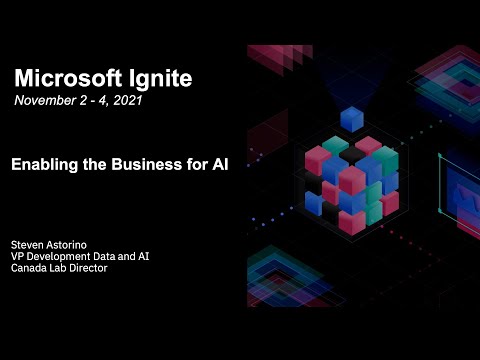Enabling the Business for AI | OD425

>> Hi everyone, and welcome. My name is Steve Astorino. Today I'll be talking to you about how you can enable your business for AI. While many organizations are struggling with the challenges of data complexity, there are some organizations who are finding success as they embrace a modern data strategy. Data-savvy organizations are more likely to use data in a manner that informs decision-making and strategically address unmet needs with new data-driven business models. When you provide organization-wide access to previously siloed data, configure governance policies and address data quality concerns, you're ready to make a large strategic AI investments that ultimately lead to outperforming revenue targets and increase profitability.
The IBM Institute of Business Value, IBV, conduct regular surveys of our organizations to identify market up-performers and looks for patterns that sets them apart. The 20th edition of the C-suite study was published in 2020 and draws input from 13,000 respondents across multiple C-suite roles, industries, and countries. In the most recent edition of the studies, companies are categorized based on their ability to create value from data and the degree to which they have integrated their data and business strategy together.
Nine percent of those companies surveyed are identified as torch-bearers who have shown that most leadership in this area. There are some striking numbers in this study about these torch-bearer companies. They're 88 percent more likely to make data-driven decisions to advance their corporate strategies. They're also a 112 percent more likely to find gaps and fill them with data-driven business models. They're 300 times more likely to enable the free sharing of data across silos in different business functions. They're also a 149 percent more likely to make large strategic investments in AI technologies.
Most importantly, they're a 178 percent more likely to outperform their industry in revenue and profitability. What's the bottom line? You must outperform your competitors on data or risk being outperformed by them. What does IBM learned from countless AI projects is that every step of the journey is critical. AI is not magic and requires a thoughtful and well-architected approach. For example, the majority of AI failures are due to problems in data preparation and data organization, not AI models themselves.
Success with AI models is dependent on achieving success first with how you collect and organize data. The AI ladder represents a prescriptive approach to help clients overcome data challenges and accelerate their journey to AI no matter where they are on that journey. It allows for them simplification and automation that turns data into insights by unifying the collection, organization, and analysis of data regardless of where that data lives. By climbing the ladder to AI, enterprises can build a governed, efficient, agile, and future-proof approach to AI. The AI ladder has four steps. They're often referred to as rungs.
The first one is collect. Make data simple and accessible. Collect data of every type, regardless of where it lives, enabling flexibility in the face of ever-changing data sources. Note that collect does not mean put data all in one place, in fact, it's quite the opposite. Virtualizing the data, allowing access to wherever it lives, as it is then consolidated.
The second rung is organize. Create a business-ready analytics foundation. Organize collect the data into a trusted business-ready foundation with built-in governance, protection, and compliance. The third one is analyze.
Build and scale AI would trust and transparency. Analyze data in automated ways and benefit from AI models that empower teams to gain new insights and make better, smarter decisions. The fourth one is infuse.
Operationalized AI throughout the business. Infuse AI across the business, across multiple departments and within various processes drawing on predictions, automation, and optimization. Supporting the AI ladder is the concept of modernization, which is how customers can simplify and automate how they turn data into insights by unifying the collection, the organization, and analysis of data regardless of where it lives within a hybrid Cloud platform. All of which is secure to help you manage risk and intelligent defend against threats.
The following priorities are built into the IBM technologies that support this AI ladder. The first one is simplicity. Different kinds of users can leverage tools that support their skill levels and goals from no code, to low code, to programmatic.
The second one's integration. As users go from one rung of the ladder to the next, the transitions are made super seamless. The other one is automation. The most common and important task have intelligence backed into them, so the users focus on innovating rather than repetitive tasks.
IBM uniquely delivers the capabilities for all the rungs of the AI ladder in IBM Cloud pack for data. One platform supporting a hybrid Cloud environment through Red Hat OpenShift, so it can run anywhere that brings all customers data in AI capabilities into one set of collaborative workflows and governance capabilities. All of which is secure to manage risk and intelligently defend against threats. However, enterprise use cases can be complex to implement. But enterprises face all sorts of complexities implementing their use cases using current approaches. For example, 360 degree MDM use cases, regulatory compliance, operational analytics, business intelligence, data science, and the list goes on.
Higher compliance, security, governance risks, complexity, and high level of effort to enforce policies and perform stewardship. Higher cost of integrating data is teaching data pipelines across multiple platforms and tools. More reliance on IT equals less business self-service, and demicrotization of data, much harder to collaborate, slow time to value.
What's needed is a new design or approach that provides an abstraction layer to share and use data with data and AI governance across the hybrid Cloud landscape without a massive pendulum swing to having everything decentralized. It's a balance between the needs to be logically or physically decentralized and what needs to be centralized. You can have multiple catalogs, but there can only be one source of the truth for the global catalog. This data fabric approach enables organizations to manage, govern, and use data to balance agility, speed, SLAs, trust, and TCO, and performance. Integration cost, egress cost, bandwidth cost, processing cost versus performance, etc. Order-of-magnitude 3,000 to 300 people to integrate for example.
You can ensure compliance and security governance, you can lower your TCO cost of integrating data and faster time to value for businesses. IBM Cloud Pak for Data embodies this and delivers this. Cloud Pak for data is an Enterprise Insight Platform, EIP, that runs on any vendor's Cloud and any infrastructure. If EIP is a new term to you, know that many industry analysts and consultants are using this term as a category for integrated sets of data management, analytics and development tools. The first core tenet of Cloud Pak for Data is that you can run it anywhere. You can co-locate where you're making your infrastructure investments.
This means you can deploy Cloud Pak for Data on every major Cloud vendor's platform, including Azure, AWS, Google Cloud Platform, and of course, IBM Cloud. You can also deploy on-premises for the case that you are developing a hybrid Cloud approach. Finally, on IBM Cloud, you can subscribe to Cloud Pak for Data as a service if you need a fully managed option where you only pay for what you use. With Cloud Pak for Data, your organization has the deployment flexibility to run anywhere. Cloud Pak for Data is built on the foundation of Red Hat OpenShift.
This provides the flexibility for customers to scale across any infrastructure using the world's leading Open Source Stuart, Red Hat. Red Hat OpenShift is a Kubernetes-based platform that allows IBM to deploy its software through a container-based model, delivering greater agility, control, and portability. IBM Cloud Pak offerings all share common control plane which makes administration and integration of diverse services easy. Cloud Pak for Data includes the set of pre-integrated data services that allow you to collect information from any repository.
This includes databases, data lakes, data warehouses, you name it. The design point here is for customers to leave the data in all the places where they already resides, but to its users, it seems like the enterprise data is in one spot. Once all your enterprise data has been connected, industry-leading data organization services can be deployed that allow for the development of an Enterprise Data Catalog. This capability enables a shop-for-data like experience and enforces governance across all the different data sources, enabling data consumers to have a single place to go for all their data needs. With your enterprise data connected and catalog, Cloud Pak for Data presents a wide variety of data analysis tools right out of the box. For example, there's a wealth of data science capabilities that cater to all skill levels, meaning, no code, low code, and all code.
Users can quickly grab data from the catalog and instantly start working towards generating insights in a common workflow built around the project concept. For additional capabilities, there are large set of extended services available for Cloud Pak for Data, that present more specialized data management and analytics capabilities as well. These range from powerful IBM solutions like planning analytics to solutions from IBM partners like Palantir to create business anthology and DataStax as an example for Open Source Database.
Recent releases of Cloud Pak for Data, take automation to the next level. New AutoSQL capabilities allow you to leave your data where it resides and connect to all structured and unstructured data without any data movement. Building on that data collection, AutoCatalog and AutoPrivacy, supercharged data discovery and ensure enforcement and governance policies across many sources and users. On top of this, we have AutoAI, which makes it easy for data analysts and data scientists to generate new models in a fast, low code manner with an award winning graphical interface and design.
The first set of new capabilities come into Cloud Pak for Data include the following; the first one is AutoSQL. This is a high performance universal query engine that simplifies the data landscape by enabling clients to use same query across different data sources, including warehouses, data lakes, streaming data, saving time and resources that would typically go into moving data and maintaining multiple query engines. In conjunction with the platforms, existing data virtualization capabilities, AutoSQL empowers users to easily query data across hybrid, multi-Cloud, and multi-vendor environments. AutoSQL includes pre-integrated data governance capabilities. Thus, data consumers are assured of the quality and validity of the data.
The other one is AutoCatalog. This automates how data is discovered in classified to maintain a real-time catalog of data assets and their relationships across different data landscapes. A critical capability of the intelligent data fabric within the platform, AutoCatalog, helps overcome the challenges faced by managing a complex, Hybrid and Multi-Cloud enterprise data landscape and helps ensure that data consumers can easily find and access the right data at the right time regardless of location. The next one is AutoPrivacy. This one employs AI to intelligently automate the identification, the monitoring, and subsequently the enforcement of policies on sensitive data across the organization.
AutoPrivacy is a key aspect of the universal data privacy framework available within IBM Cloud Pak for Data. Spanning the entire data and AI life-cycle, this framework allows business leaders to provide the self-service access data consumers need without sacrificing security or compliance. Building a better strategy for governance risk and compliance by eliminating compliance blind spots and minimizing risks. The other one's AutoAI, automates data preparation, model development and feature engineering to train and deploy top-performing models in minutes, simplify the AI life-cycle management to build models faster, accelerate deployment, and open up AI to broader skill sets. So think of that data fabric as the magic that helps make more of your data apps and services ready for AI. Automating an augmenting a lot of the steps that would otherwise have to be undertaken by large groups of architects, administrators, and data scientists.
In this example, you can see conceptually how data and other services across a Hybrid Multi-Cloud environment can be leveraged more transparently using the data fabric design and approach. As an example, customers who have their data in Azure, can leverage it without moving it out of Azure and still be able to deliver the apps and services that they want or they need. This delivers a higher performance and lowers the cost, both from a data storage perspective and reduced ETL.
IBM's open information architecture for AI is built upon Cloud Pak for Data on Red Hat OpenShift, built for a Hybrid Cloud World. What does this mean? In other words, flexibility. To further explain, consider the following. If an organization is in place where they need to manage as little IT as possible, they can consume Cloud Pak for Data entirely through as a service model by subscribing to the integrated family of data services on IBM Cloud.
If an organization needs flexibility and control of running data infrastructure in their own data center or an IIS Infrastructure as a Service from your preferred Cloud vendor, you can then deploy OpenShift and then Cloud Pak for Data on your local or Cloud estate. If high performance and total control are needed, you can choose the Cloud Pak for Data System, which is a hyper converged infrastructure that combines compute, storage and network services that are optimized for OpenShift and data and AI workloads. So as you can see, regardless of the form factor and the degree of management control needed, Cloud Pak for Data provides Cloud needed data management services that modernizes how businesses collect, organize, and analyze data, then infused AI throughout their organization. We have many client success stories that demonstrate the value organizations have gained from Cloud Pak tor Data running on Azure and leveraging the data fabric. For example, this North American Aerospace Company.
What was their business challenge? They needed to modernize and standardize their business infrastructure, being able to have a clear view of metadata throughout its various lines of businesses and shared information technology across. They needed metadata consolidation to provide a 360-degree view to increase productivity. They wanted to have a single source of truth across different data sources and location. What was the solution? They use Cloud Pak for Data on Azure, which can provide them with access to all Inputs, outputs, who uses it for data access, where it originates from for data lineage and data transformation from point A to point B and more. The new solution will not only provide a powerful metadata search capability, but also reporting and visualization across their enterprise estate.
What was the outcome? The outcome was an infrastructure overhaul. They had data access controls, lineage, and transformation all across. They had a 360 degree view of their data.
What was the solution? It was Data Fabric, IBM Cloud Pak for Data on Azure with IBM Watson knowledge catalog services from IBM's Expert Labs Teams as well, a huge success overall. IBM data and AI technologies are recognized across 12 Gartner Group Magic Quadrants. Nine in the leader quadrant with a greater than 4.5 rating for Gartner peerinsight. We're super-excited about this. In closing, I want to show you what the results look like when using Cloud Pak for Data to speed up data-driven transformation. According to a third party source, customers can reduce and extract, transform and load ETL request by up to 64 percent, realize data science and AI benefits in addition to reduced infrastructure management efforts by up to 85 percent.
More details can be found in the Forrester New Tech Total Economic Impact report. Please take a look at it. If you're wondering where to get started on your journey to AI, you can take a free business value assessment to identify where you are and what you need to do to progress your journey. Finally, I invite you to sign up for a trial of Cloud Pak for Data as a service. Thank you everyone and have a great conference.
2021-11-07 20:32


